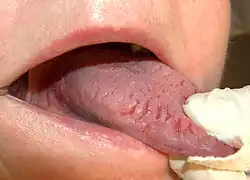Fissured tongue
| Fissured tongue | |
|---|---|
| Other names: Scrotal tongue, Lingua plicata, plicated tongue, furrowed tongue[1] | |
 | |
Fissured tongue is a harmless condition characterized by deep grooves in the top of of the tongue.[1] Although these grooves may look unsettling, the condition is usually painless. Some individuals may complain of an associated burning sensation.[2]
It is a relatively common condition, with a prevalence of between 6.8%[3] and 11%[4] found also in children. Often hereditary, may also be part of degenerative process. The prevalence of the condition increases significantly with age, occurring in 40% of the population after the age of 40.[5]
Signs and symptoms
The clinical appearance is considerably varied in both the orientation, number, depth and length of the fissure pattern. There are usually multiple grooves/furrows 2–6 mm in depth present. Sometimes there is a large central furrow, with smaller fissures branching perpendicularly. Other patterns may show a mostly dorsolateral position of the fissures (i.e. sideways running grooves on the tongue's upper surface). Some patients may experience burning or soreness.
.jpg.webp) Fissured tongue
Fissured tongue.jpg.webp) Fissured tongue
Fissured tongue.jpg.webp) Fissured tongue
Fissured tongue Fissured tongue
Fissured tongue
Associated conditions
Fissured tongue is seen in Melkersson-Rosenthal syndrome (along with facial nerve paralysis and granulomatous cheilitis). It is also seen in most patients with Down syndrome, in association with geographic tongue, in patients with oral manifestations of psoriasis, and in healthy individuals. Fissured tongue is also sometimes a feature of Cowden's syndrome.
Cause
The cause is unknown, but it may be partly a genetic trait. Aging and environmental factors may also contribute to the appearance.
Prevalence
It is a relatively common condition, with an estimated prevalence of 6.8%[3]–11%.[4] Males are more commonly affected. The condition may be seen at any age, but generally affects older people more frequently. The condition also generally becomes more accentuated with age. The prevalence of the condition increases significantly with age, occurring in 40% of the population after the age of 40.[5]
References
- 1 2 James, William D.; Elston, Dirk; Treat, James R.; Rosenbach, Misha A.; Neuhaus, Isaac (2020). "34. Disorders of the mucous membranes". Andrews' Diseases of the Skin: Clinical Dermatology (13th ed.). Edinburgh: Elsevier. p. 799. ISBN 978-0-323-54753-6. Archived from the original on 2022-05-07. Retrieved 2022-05-07.
- ↑ Scully, Crispian (2008). Oral and maxillofacial medicine: the basis of diagnosis and treatment (2nd ed.). Edinburgh: Churchill Livingstone. ISBN 9780443068188.
- 1 2 FREQUENCY OF TONGUE ANOMALIES AMONG YEMENI CHILDREN IN DENTAL CLINICS Archived 2018-10-29 at the Wayback Machine Yemeni Journal for Medical Sciences
- 1 2 Frequency of Tongue Anomalies in Primary School Of Lahidjan Archived 2020-06-29 at the Wayback Machine Rabiei M, Mohtashame Amiri Z, Masoodi Rad H, Niazi M, Niazi H. Frequency of Tongue Anomalies in Primary School Of Lahidjan. 3. 2003; 12 (45) :36-42 ]
- 1 2 Geriatric Nutrition: The Health Professional's Handbook, Ronni Chernoff, (Jones & Bartlett Learning, 2006), page 176
External links
| Classification | |
|---|---|
| External resources |